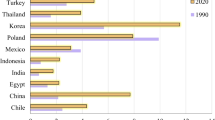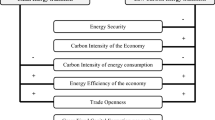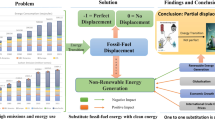Abstract
The aim of this paper is to examine the spatial distribution of non-\(\hbox {CO}_2\) generating energy sources in the world for the period 1990–2009, paying special attention to the evolution of cross-country disparities. To this end, after carrying out a classical convergence analysis, a more thorough investigation of the entire distribution is presented by examining its external shape, the intra-distribution dynamics and the long-run equilibrium distribution. This analysis reveals the existence of a weak, rather insignificant, convergence process and that large cross-country differences are likely to persist in the long-run. Next, as polarization indicators are a proper way of appraising potential conflict in international environmental negotiations, we test whether, or not, the distribution dynamics concurs with the presence of polarization. Our results indicate that two poles can be clearly differentiated, one with high and other with low non-\(\hbox {CO}_2\) generating energy shares. In view of these findings, and to ensure a fair transition to a sustainable energy system, the paper calls for the development of an ambitious clean energy agenda, especially in countries with low non-\(\hbox {CO}_2\) generating energy shares.




Similar content being viewed by others
Notes
Both terms, clean energy and non-\(\hbox {CO}_2\) generating energy sources, are used indistinctly in this paper.
As Pretty (2013) suggests, the pathway to economic growth of developing countries does not have to be the same as those followed by the currently developed ones.
Under other definitions clean energy can also include cleaner fossil fuels such as clean coal or some low carbon energy sources.
The classical convergence approach is based on the seminal paper by Barro and Sala-i-Martin (1992). They proposed two measures of convergence, \(\upsigma \)- and \(\upbeta \)-convergence. As the concept of \(\upbeta \)-convergence is less restrictive than the first one, we only show \(\upsigma \)-convergence results; in fact, \(\upbeta \)-convergence is a necessary but not sufficient condition for \(\upsigma \)-convergence.
Therefore, we have \(\frac{CE}{TEU}=\frac{CE}{GDP}*\frac{GDP}{POP}*\frac{POP}{TEU}=CEI*EA*IEPC\), where CE denotes clean energy, TEU refers to total energy use, and POP is population.
Although clean energy data provided by the World Bank are not split between nuclear and renewable sources, we proxied them by comparing the “electricity production from nuclear sources” and the “electricity production from renewable sources”.
This analysis was conducted by using STATA’s akdensity command. Regarding weights, we used analytic weights (aweight), that is, weights that are inversely proportional to the variance of each observation; for example, the variance of the i-th observation is assumed to be \(\sigma ^{2}/w_{i}\), where \(w_{i}\) is the weight, namely the population of country \(i\).
Alternative methods for the discretization of the distribution include the proposal by Scott (1979), who defines an optimal bin width as a function of the sample size and the standard deviation, or the proposal by Magrini (1999) based on the minimization of an error measure. These methods of boundary selection, however, may lead to having a disproportionate number of states, some of them, as indicated by Bosker (2009), with very few observations.
Whereas a 1-year transition period, for example, would imply a very low degree of mobility and emerging patterns would be really difficult to detect, a longer transition period would lead, in the case of discrete-time estimation, to a noteworthy loss of information.
Before proceeding with the estimation, we first tested for the existence of Markovian dependence using the \(\chi ^{2}\)-test proposed by Anderson and Goodman (1957). The results lead us to reject the null hypothesis of non-Markovian dependence at the 5 % significant level (\(p\)-value \(=\) 0.000), this implying we can properly compute a transition matrix.
An excellent, comprehensive survey—and application—of these mobility indices can be seen in Duro (2013).
For the sake of simplicity the equations of the paper contain no reference to time.
In the original version of the mobility index proposed by Maza et al. (2010b) the element \(p_i\) is defined as the proportion of countries in each state at \(t\). This definition implied weighting all transitions equally irrespective of countries’ size.
Empirical evidence has revealed that there is not significant increase in the explanatory power when more than 4 groups are taken into account.
To this respect, Montini (2011) highlights that one of the major problems surrounding the present climate change regime is the challenge of fragmentation of negotiations.
In the last year of our sample, for example, the group characterized by low clean energy share reached only 42 % of the world average, while the high clean energy share group reached 234 % of the world average.
For an excellent paper studying the conditions to achieve an unilateral climate action see Bosetti and De Cian (2013).
References
Abramson IS (1982) On bandwidth variation in kernel estimates: a square root law. Ann Stat 10(4):1217–1223
Amer M, Daim TU (2011) Selection of renewable energy technologies for a developing county: a case of Pakistan. Energy Sustain Dev 15(4):420–435
Anderson TW, Goodman LS (1957) Statistical inference about Markov chains. Ann Math Stat 28:89–109
Barrett JP, Hoerner JA (2002) Clean energy and jobs: a comprehensive approach to climate change and energy policy. Economic Policy Institute, Washington, DC
Barro R, Sala-i-Martin X (1992) Convergence. J Polit Econ 100(21):223–251
Bartholomew DJ (1996) The statistical approach to social measurement. Academic Press, London
Bichenbach F, Bode E (2003) Evaluating the Markov property in studies of economic convergence. Int Reg Sci Rev 26(3):363–392
Böhringer C, Keller A, van der Werf E (2013) Are green hopes too rosy? Employment and welfare impacts of renewable energy promotion. Energy Econ 36:277–285
Bollino CA (2009) The willingness to pay for renewable energy sources: the case of Italy with socio-demographic determinants. Energy J 30(2):81–96
Borchers AM, Duke JM, Parsons GR (2007) Does willingness to pay for green energy differ by source? Energy Policy 35(6):3327–3334
Bosetti V, De Cian E (2013) A goof opening: the key to make the most of unilateral climate action. Environ Resour Econ. doi:10.1007/s10640-013-9643-1
Bosker M (2009) The spatial evolution of regional GDP disparities in the old and the new Europe. Pap Reg Sci 88:3–27
Brown MA (2001) Market failures and barriers as a basis for clean energy policies. Energy Policy 29(14):1197–1207
Cooper RN (2012) Financing for climate change. Energy Econ 34(S1):S29–S33
Duro JA (2005) Another look to income polarization across countries. J Policy Model 27:1001–1007
Duro JA (2012) On the automatic application of inequality indexes in the analysis of the international distribution of environmental indicators. Ecol Econ 76:1–7
Duro JA (2013) International mobility in carbon dioxide emissions. Energy Policy 55:208–216
Duro JA, Padilla E (2008) Analysis of the international distribution of per capita CO\(_{2}\) emissions using the polarization concept. Energy Policy 36:456–466
Duro JA, Padilla E (2013) Cross-country polarization in CO2 emissions per capita in the European Union: changes and explanatory factors. Environ Resour Econ 54(4):571–591
Durrett R (1999) Essentials of stochastic processes. Springer, Berlin
Esteban JM, Gradín C, Ray D (1999) Extensions of a measure of polarization with an application to the income distribution of five OECD countries. Luxembourg Income Study Working Paper Series 218, Maxwell School of Citizenship and Public Affairs, Syracuse University, Syracuse, New York
Esteban JM, Gradín C, Ray D (2007) An extension of a measure of polarization, with an application to the income distributions of five OECD countries. J Econ Inequal 5:1–19
Esteban JM, Ray D (1994) On the measurement of polarization. Econometrica 62:819–852
Esteban JM, Ray D (1999) Conflict and distribution. J Econ Theory 87:379–415
Ezcurra R (2007) Is there cross-country convergence in carbon dioxide emissions? Energy Policy 35:1363–1372
Ezcurra R, Pascual P, Rapún M (2007) Spatial disparities in the European Union: an analysis of regional polarization. Ann Reg Sci 41:401–429
Goerlich Gisbert FJ (2003) Weighted samples, kernel density estimators and convergence. Empir Econ 28:335–351
Golombek R, Hoel M (2011) International cooperation on climate-friendly technologies. Environ Resour Econ 49:473–490
Haines A, Smith KR, Anderson D et al (2007) Policies for accelerating access to clean energy, improving health, advancing development, and mitigating climate change. Lancet 270(9594):1264–1281
Herrerias MJ (2012) CO2 weighted convergence across the EU-25 countries (1920–2007). Appl Energy 92:9–16
Hierro M, Maza A (2009) Structural shifts in the dynamics of the European income distribution. Econ Model 26(3):733–739
Hierro M, Maza A, Villaverde J (2012) Explaining polarisation in the EU27’s international migration distribution. Tijdschr Econ Soc Geogr 103(4):396–411
Kammen DM, Kapadia K, Fripp M (2004) Putting renewables to work: how many jobs can the clean energy industry generate? RAEL Report, University of California, Berkeley
Lund PD (2010) Fast market penetration of energy technologies in retrospect with application to clean energy futures. Appl Energy 87(11):3575–3583
Magrini S (1999) The evolution of disparities among the regions of the European Union. Reg Sci Urban Econ 29:257–281
Maza A, Hierro M, Villaverde J (2010a) Renewable electricity consumption in the EU-27: are cross-country differences diminishing? Renew Energy 35(9):2094–2101
Maza A, Hierro M, Villaverde J (2010b) Measuring intra-distribution dynamics: an application of different approaches to the European regions. Ann Reg Sci 45(2):313–329
Maza A, Villaverde J (2008) The world per capita electricity consumption distribution: signs of convergence? Energy Policy 36(11):4255–4261
Montini M (2011) Reshaping climate governance for post-2012. Eur J Legal Stud 4(1):7–24
Moreno B, López AJ (2008) The effect of renewable energy on employment. The case of Asturias (Spain). Renew Sustain Energy Rev 12(3):732–751
Morris AC, Nivola PS, Schultze CL (2012) Clean energy: revisiting the challenges of industrial policy. Energy Econ 34(S1):S34–S42
Nguyen-Van P (2005) Distribution dynamics of CO2 emissions. Environ Resour Econ 32(4):495–508
Padilla E, Duro A (2013) Explanatory factors of CO2 per capita emission inequality in the European Union. Energy Policy 62:1320–1328
Parzen E (1962) Stochastic processes. Holden-Day, San Francisco
Pollin R (2012) Public policy, community ownership and clean energy. Camb J Reg Econ Soc 5(3):339–356
Pretty J (2013) The consumption of a finite planet: well-being, convergence, divergence and the nascent green economy. Environ Resour Econ. doi:10.1007/s10640-013-9680-9
Quah D (1993) Empirical cross-section dynamics in economic growth. Eur Econ Rev 37:426–434
Quah D (1996) Regional convergence clusters in Europe. Eur Econ Rev 40(3–5):951–958
Quah D (1997) Empirics for growth and distribution: stratification, polarisation, and convergence clubs. J Econ Growth 2:27–59
Scarpa R, Willis K (2010) Willingness-to-pay for renewable energy: primary and discretionary choice of British households’ for micro-generation technologies. Energy Econ 32(1):129–136
Scott DW (1979) Optimal and data-based histograms. Biometrika 66:605–610
Shafiullah GM, Amanullah MTO, Shawkat Ali ABM et al (2012) Prospects of renewable energy—a feasibility study in the Australian context. Renew Energy 39(1):183–197
Shorrocks AF (1978) The measurement of mobility. Econometrica 46:1013–1024
Silverman BW (1986) Density estimation for statistics and data analysis. Chapman and Hall, London
Sinn WH (2007) Pareto optimality in the extraction of fossil fuels and the greenhouse effect. CESIFO working paper no. 2083
Sinn WH (2008) Public policies against global warming: a supply side approach. Int Tax Public Financ 15(4):360–394
Spinesi L (2012) Global warming and endogenous technological change: revisiting the green paradox. Environ Resour Econ 51:545–559
Tourkolias C, Mirasgedis S (2011) Quantification and monetization of employment benefits associated with renewable energy technologies in Greece. Renew Sustain Energy Rev 15(6):2876–2886
van Ruijven BJ, van Vuuren DP, van Vliet J et al (2012) Implications of greenhouse gas emission mitigation scenarios for the main Asian regions. Energy Econ 34(S3):S459–S469
VijayaVenkataRaman S, Iniyan S, Goic R (2012) A review of climate change, mitigation and adaptation. Renew Sustain Energy Rev 16(1):878–897
Wei M, Patadia S, Kammen DM (2010) Putting renewables and energy efficiency to work: how many jobs can the clean energy industry generate in the US? Energy Policy 38(2):919–931
Author information
Authors and Affiliations
Corresponding author
Additional information
We would like to thank two anonymous referees for their helpful comments and suggestions. The usual disclaimer applies.
Appendices
Appendix 1: List of Countries
Albania | Georgia | New Zealand |
Algeria | Germany | Nicaragua |
Angola | Ghana | Nigeria |
Argentina | Greece | Norway |
Armenia | Guatemala | Pakistan |
Australia | Haiti | Panama |
Austria | Honduras | Paraguay |
Azerbaijan | Hungary | Peru |
Bangladesh | Iceland | Philippines |
Belarus | India | Poland |
Belgium | Indonesia | Portugal |
Bolivia | Iran, Islamic Rep. | Romania |
Bosnia and Herzegovina | Iraq | Russian Federation |
Brazil | Ireland | Serbia |
Bulgaria | Israel | Slovak Republic |
Cameroon | Italy | Slovenia |
Canada | Jamaica | South Africa |
Chile | Japan | Spain |
China | Jordan | Sri Lanka |
Colombia | Kazakhstan | Sudan |
Congo, Dem. Rep. | Kenya | Sweden |
Congo, Rep. | Korea, Dem. Rep. | Switzerland |
Costa Rica | Korea, Rep. | Syrian Arab Republic |
Cote d’Ivoire | Kyrgyz Republic | Tajikistan |
Croatia | Latvia | Tanzania |
Cuba | Lebanon | Thailand |
Cyprus | Lithuania | Togo |
Czech Republic | Luxembourg | Tunisia |
Denmark | Macedonia, FYR | Turkey |
Dominican Republic | Malaysia | Ukraine |
Ecuador | Mexico | United Kingdom |
Egypt, Arab Rep. | Moldova | United States |
El Salvador | Morocco | Uruguay |
Estonia | Mozambique | Uzbekistan |
Ethiopia | Myanmar | Venezuela, RB |
Finland | Namibia | Vietnam |
France | Nepal | Zambia |
Gabon | Netherlands | Zimbabwe |
Appendix 2: Country Clusters
Low clean energy share | High clean energy share |
|---|---|
Algeria | Albania |
Angola | Argentina |
Australia | Armenia |
Azerbaijan | Austria |
Bangladesh | Belgium |
Belarus | Bosnia and Herzegovina |
Bolivia | Brazil |
Cameroon | Bulgaria |
China | Canada |
Congo, Dem. Rep. | Chile |
Congo, Rep. | Colombia |
Cote d’Ivoire | Costa Rica |
Cuba | Croatia |
Cyprus | Czech Republic |
Denmark | Ecuador |
Dominican Republic | El Salvador |
Egypt, Arab Rep. | Finland |
Estonia | France |
Ethiopia | Georgia |
Gabon | Germany |
Ghana | Hungary |
Greece | Iceland |
Guatemala | Indonesia |
Haiti | Japan |
Honduras | Kenya |
India | Korea, Rep. |
Iran, Islamic Rep. | Kyrgyz Republic |
Iraq | Latvia |
Ireland | Lithuania |
Israel | Mozambique |
Italy | Namibia |
Jamaica | New Zealand |
Jordan | Nicaragua |
Kazakhstan | Norway |
Korea, Dem. Rep. | Panama |
Lebanon | Paraguay |
Luxembourg | Peru |
Macedonia, FYR | Philippines |
Malaysia | Romania |
Malaysia | Romania |
Mexico | Russian Federation |
Moldova | Slovak Republic |
Morocco | Slovenia |
Myanmar | Spain |
Nepal | Sweden |
Netherlands | Switzerland |
Nigeria | Tajikistan |
Pakistan | Ukraine |
Poland | United Kingdom |
Portugal | United States |
Serbia | Uruguay |
South Africa | Venezuela, RB |
Sri Lanka | Zambia |
Sudan | |
Syrian Arab Republic | |
Tanzania | |
Thailand | |
Togo | |
Tunisia | |
Turkey | |
Uzbekistan | |
Vietnam | |
Zimbabwe |
Rights and permissions
About this article
Cite this article
Maza, A., Villaverde, J. & Hierro, M. Non-\(\hbox {CO}_2\) Generating Energy Shares in the World: Cross-Country Differences and Polarization. Environ Resource Econ 61, 319–343 (2015). https://doi.org/10.1007/s10640-014-9794-8
Accepted:
Published:
Issue Date:
DOI: https://doi.org/10.1007/s10640-014-9794-8




